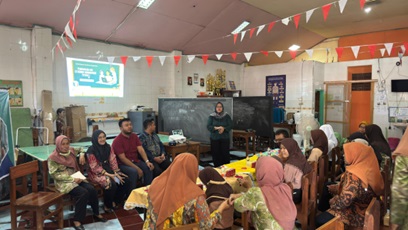Rancang Bangun Difabel Experience Management Learning bagi Anak Berkebutuhan Khusus pada Sekolah Luar Biasa Sasanti Wiyata
Designing Difabel Experience Management Learning for Children with Special Needs at Sasanti Wiyata Special School
DOI:
https://doi.org/10.33084/pengabdianmu.v9i12.8305Keywords:
Special Needs School, Difabel Experience Management Learning, Children with Special NeedsAbstract
Sasanti Wiyata Special School (SLB) is one of the special schools in Surabaya that has students with special needs. The results from the focus group discussion revealed the partners' issues, namely the lack of utilization of information and communication technology and the insufficient digital learning experiences for children with special needs. This community service activity aims to enhance the partners' skills in using digital-based learning methods and to improve the abilities of students with special needs in utilizing digital technology for learning. The method of implementing this community service is carried out by providing training, assistance, and evaluation of activities. The training and mentoring were measured using pre-tests and post-tests. The pre-tests and post-tests were processed using descriptive statistics, which showed an improvement in the understanding and skills of the teachers in creating, using, and integrating learning materials on the DXML (Difabel Experience Management Learning) platform. This platform serves as a tool that integrates the Learning Management System (LMS) and the Learning Experience Platform (LXP). The advantage (value proposition) of the synergy between the implementation of LMS and LXP is the customizable DXML that can be tailored to the characteristics of children with special needs at SLB Sasanti Wiyata, specifically those who are hearing impaired and intellectually disabled. From this activity, an increase in the skills of teachers and students in using the DXML digital platform was achieved, making the teaching and learning process easier. Therefore, this community service needs to be carried out continuously.
Downloads
References
Suparno. (2007). Pendidikan Anak Berkebutuhan Khusus. Jakarta: Dirjen Dikti Depdiknas. http://dx.doi.org/10.21831/diklus.v4i1.30940
Kemendikbud Indonesia. Kurikulum Merdeka: Pembelajaran dengan Paradigma Baru dan Berdiferensiasi [Internet]. (2022) cited 2024 June 14. Available from: Kurikulum Merdeka: Pembelajaran dengan Paradigma Baru dan Berdiferensiasi. https://www.kemdikbud.go.id/main/blog/2022/02/kurikulum-merdeka-pembelajaran-dengan-paradigma-baru-dan-berdiferensiasi
Ninta AIS, Hadi MS. (2023)Pemanfataan Aplikasi Canva Sebagai Media Pembelajaran Masa Kini dalam Kurikulum Merdeka. AL-Tarbiyah: Jurnal Ilmu Pendidikan Islam 1(3). https://doi.org/10.47498/meuseuraya.v3i2.3573
Xavier EM, Marcon Y, Avraam D, Banerjee S, Bishop TRP, Burton P, et al. (2023) Software Application Profile: ShinyDataSHIELD—an R Shiny application to perform federated non-disclosive data analysis in multicohort studies. Int J Epidemiol 8; 52 (1):315–20. http://dx.doi.org/10.1093/ije/dyac201
Ke F. . (2016). Designing and integrating purposeful learning in game play: a systematic review. Educational Technology Research and Development 64(2). http://dx.doi.org/10.1007/s11423-020-09908-9
Maghool Sah, Moeini Sh (Iradj), Arefazar Y. (2018) An Educational Application Based On Virtual Reality Technology for Learning Architectural Details: Challenges and Benefits. International Journal of Architectural Research: Archnet-Ijar 12(3):246. http://dx.doi.org/10.26687/archnet-ijar.v12i3.1719
Osborne O’Hagan A, Coleman G, O’Connor R V. (2014) Software Development Processes for Games: A Systematic Literature Review p. 182–93. http://dx.doi.org/10.1007/978-3-662-43896-1_16
Phan MH, Keebler JR, Chaparro BS. (2016) The Development and Validation of the Game User Experience Satisfaction Scale (GUESS). Human Factors: The Journal of the Human Factors and Ergonomics Society 27; 58(8):1217–47. http://dx.doi.org/10.1177/0018720816669646
Scherer R, Siddiq F, Tondeur J. (2019) The technology acceptance model (TAM): A meta-analytic structural equation modeling approach to explaining teachers’ adoption of digital technology in education. Comput Educ 128:13–35. https://doi.org/10.1016/j.compedu.2018.09.009
Tokarieva A V., Volkova NP, Harkusha I V., Soloviev VN. (2019) Educational digital games: models and implementation. Educational Dimension 1:5–26. https://doi.org/10.31812/educdim.v53i1.3872
Klabbers JH. (2018) On the Architecture of Game Science. Simul Gaming. 49(3):207–45. https://doi.org/10.1177/1046878118762534.
Sunani, A., Ridho, W.F., Al haromainy, M.M., Safitri, F.I., Permatasari, L.P., (2024). Pendampingan Program Santripreneur berbasis Kewirausahaan Digital pada Santri Pondok Pesantren Jabal Noer Sidoarjo Jawa Timur. To Maega: Jurnal Pengabdian Masyarakat 7(1), 125-136. https://doi.org/10.36728/jpf.v6i1.4351

Downloads
Published
How to Cite
Issue
Section
License
Copyright (c) 2024 Avi Sunani, Augustin Mustika Chairil, Muhammad Muharrom Al Haromainy, In Naka Malik Hardiansyah, Theressa Marry Christianty, Achmad Derajat Waskito

This work is licensed under a Creative Commons Attribution-ShareAlike 4.0 International License.
Authors who publish with this journal agree to the following terms:
- Any article on the copyright is retained by the author(s).
- Author grant the journal, right of first publication with the work simultaneously licensed under a Creative Commons Attribution License that allows others to share work with acknowledgment of the work authors and initial publications in this journal.
- Authors are able to enter into a separate, additional contractual arrangements for non-exclusive distribution of published articles of work (eg, post-institutional repository) or publish it in a book, with acknowledgment of its initial publication in this journal.
- Authors are permitted and encouraged to post their work online (e.g., in institutional repositories or on their websites) prior to and during the submission process, as can lead to productive exchanges, as well as earlier and greater citation of published work.
- The article and any associated published material is distributed under the Creative Commons Attribution-ShareAlike 4.0 International License










